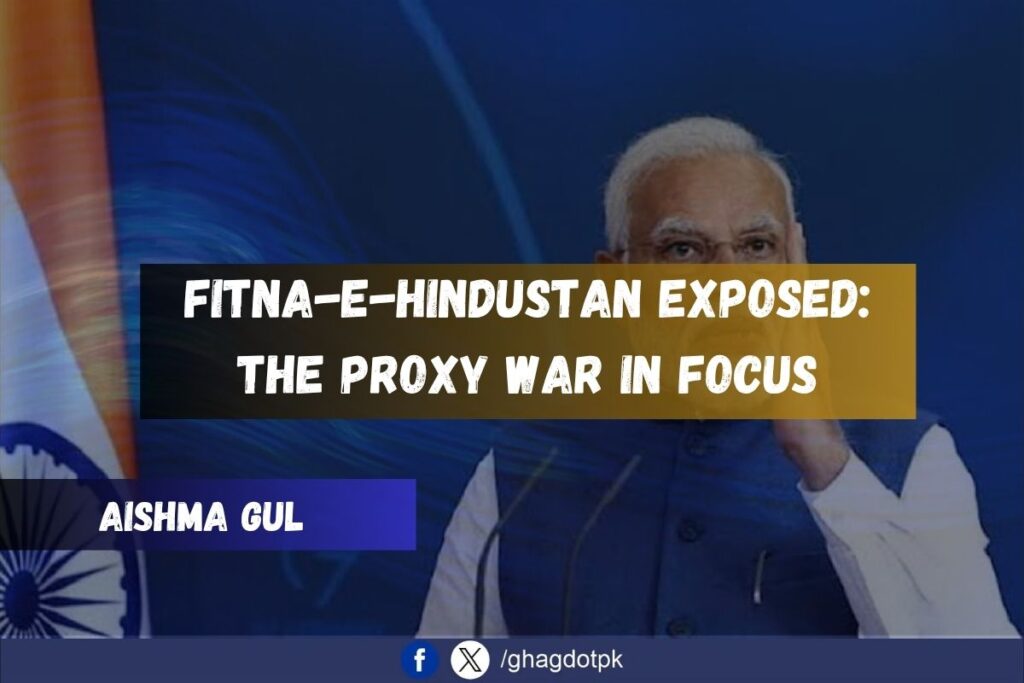By Aishma Gul
“Peace is our first choice; if India commits folly again, our response will be even more severe than before” – DG ISPR
In recent months, Pakistan has found itself under a fresh wave of covert attacks by Fitna-e-Hindustan, a name now tied to alleged Indian covert operations designed to shake the country’s stability. These tactics range from targeting people abroad to plotting violence inside Pakistan. What we’ve seen is a clear plan to weaken the nation through fear and force. Our own security moves and public warnings are more than reactions; they’re part of a growing effort to reveal and fight back against a campaign built on aggression and hidden agendas.
Origins and Allegations of State Sponsorship
– 2009 Dossier (Sharm el-Sheikh): Pakistan gave the world intercepted messages and money-trail documents showing Indian agencies backing Baloch rebels.
– 2015 UN Submission: A fuller report was sent to the United Nations, pointing to weapons stockpiles and training sites inside India.
– 2016 Kulbhushan Yadav Arrest: An Indian naval officer, in Pakistan’s custody, admitted he helped set up terror cells in Balochistan under orders from New Delhi.
– 2019 UN Resubmission: Another batch of forensic evidence was handed over to the UN, reinforcing earlier claims.
DG ISPR made it clear that these repeated revelations track nearly twenty years of “state terrorism” aimed at border provinces. By repeatedly submitting detailed reports (in 2009, 2015, and 2019) and highlighting everything from intercepted messages to weapons caches, Pakistan has built a solid, evidence-driven case that survives mere denial.
Major Incidents and Timeline of Violence
Below is a simple, year-by-year list of major attacks and warnings tied to Fitna-e-Hindustan:
2023
– 4 November: Social media hinted at a “big day” before militants struck Manawan Air Base in Punjab.
2024
– 12 April (Panjpai, Nushki): 12 labourers were shot dead.
– 28 April (Turbat, Kech): Two labourers were killed at their work site.
– 9 May (Sorbandar, Gwadar): Seven barbers were murdered in their homes in a dawn raid.
– 26 August (Mashkhel): A bus was ambushed; 22 passengers died and the vehicle burned.
– 28 September (Khudaban, Panjgur): Seven labourers were lined up and executed.
– 6 October (Karachi): A warned attack hit Chinese construction workers.
– 10 October (Duki): 21 miners were killed and seven injured in a tunnel assault.
– 13 November (Ziarat): Gunmen attacked a passenger bus, killing three.
2025
– 10 February (Kech): Two tailors were shot in their shop.
– 14 February (Harnai): An IED exploded in a market, killing ten civilians.
– 19 February (Barkhan): Seven people were dragged off a bus and shot.
– 9 March (Panjgur): Three barbers were killed before dawn.
– 11 March (Jaffar Express): The train was ambushed; both civilians and soldiers on leave were martyred.
– 26 March (Gwadar): Six poor labourers were shot dead near the port.
– 6–7 May: Pakistan successfully hit the airbases used by hostile jets, with no harm to civilians.
– 9–21 May: A wave of raids in Lasbela, Nushki, and Khuzdar left at least 40 civilians dead (22 children) and 51 wounded.
Looking at the timeline, it’s clear these strikes weren’t haphazard: labourers, barbers, miners, even bus passengers were hit at moments chosen to sow maximum fear and disrupt everyday life.
Confessions, Evidence, and Propaganda
– Indian Major Sandeep Audio: While in custody, he admitted organizing attacks “from Lahore to Balochistan,” offering what Pakistan calls “irrefutable evidence.”
– Voluntary Surrenders: Recently, captured militants on TV said they got daily orders and money from Indian handlers.
– Media Collusion: DG ISPR pointed out how some Indian news and social platforms announce attacks in advance (for example, at Manawan, Karachi, Jaffar Express) and then celebrate them—unlike Pakistan’s forces, which avoid civilian harm.
Pakistan’s Counterterrorism Measures
January 2024–May 2025:
– 4,664 terrorist acts nationwide (1,612 in Balochistan).
– 93,515 counterterror operations (52,887 in Balochistan).
– 1,018 terrorists neutralized in 2024 (223 in Balochistan); 747 so far in 2025 (203 in Balochistan).
– Focus on Intelligence: Under the National Action Plan, security agencies have broken up dozens of terror cells.
– Protecting Civilians: Airbases used for raids on May 6–7 were secured without civilian damage.
– Interior Ministry Role: Secretary Muhammad Khurram Agha confirmed that early investigations link the Khuzdar school attack to Fitna-e-Hindustan and announced “Operation Zarb-e-Azb II” to wipe out the group.
Regional and International Dimensions
– Afghanistan Link: Pakistan tells Kabul, “Don’t let terrorists use your land—do not become India’s tools.”
– Water Threats: DG ISPR called any move to choke Pakistan’s share of river water “madness” that would hurt 240 million people.
– Protecting Sikh Sites: Pakistan says it stopped drone strikes on Sikh shrines in Amritsar and Nankana Sahib, showing it honors all faiths.
– Kashmir Question: Both nations agree peace hinges on a fair solution for Kashmir under UN resolutions.
Without a global body to probe and punish this kind of proxy warfare, South Asia stays at risk. And because this goes beyond bombs—touching on water rights, sacred sites, and cross-border sanctuaries—the issue spills into human rights, environment, and regional politics, drawing broader attention and pressure.
Fitna-e-Hindustan shows a worrying new form of conflict—states hiding behind proxy fighters to strike at rivals while keeping their hands “clean.” Pakistan’s blend of clear evidence gathering, precise military action, and appeals to international bodies has reduced some risks. Yet achieving lasting security requires parallel diplomatic efforts—such as a UN inquiry, confidence-building along borders, and cooperative development projects—to break the cycle of retaliation and reach the peace Pakistan prioritizes.






